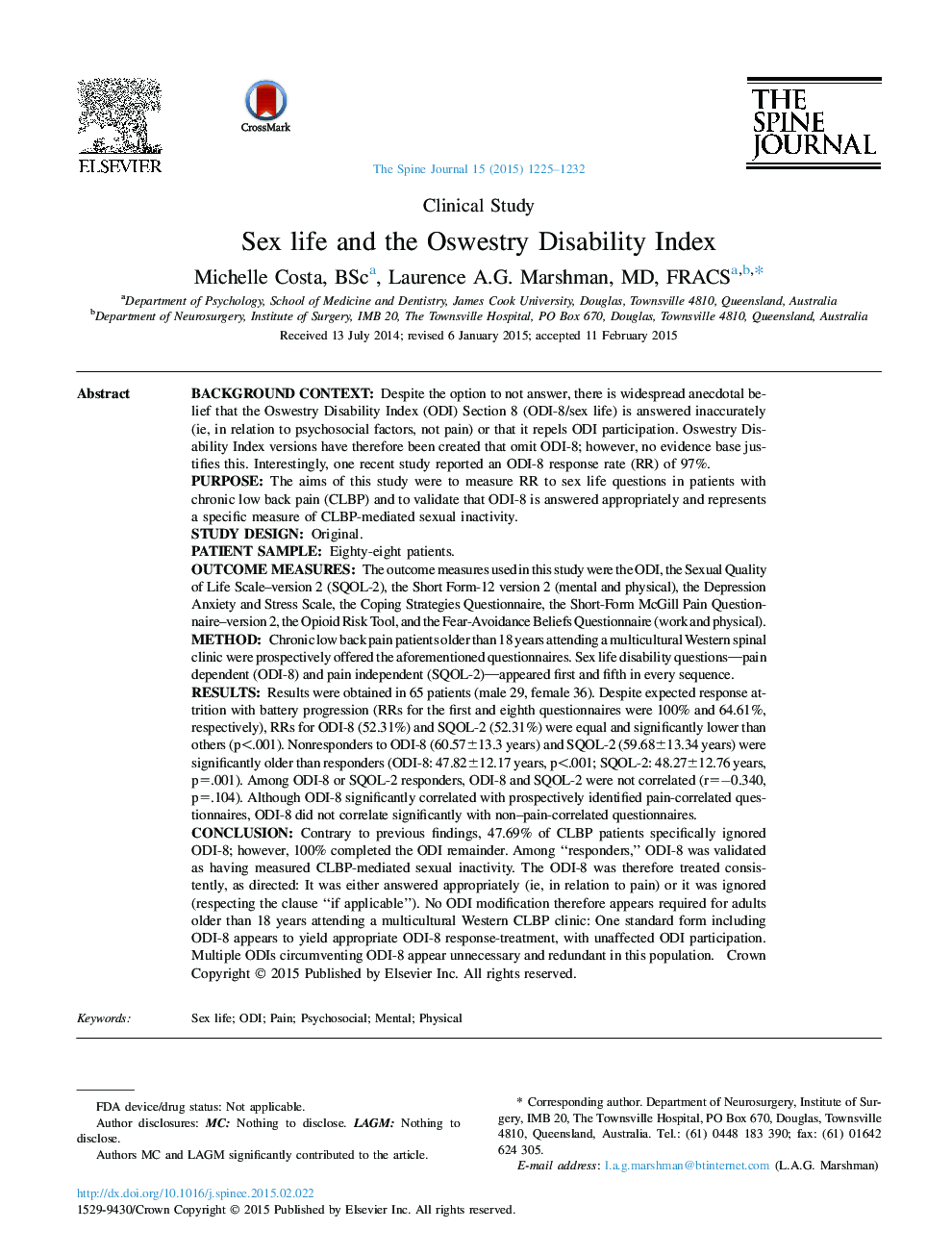| کد مقاله | کد نشریه | سال انتشار | مقاله انگلیسی | نسخه تمام متن |
|---|---|---|---|---|
| 6211885 | 1268561 | 2015 | 8 صفحه PDF | دانلود رایگان |

Background contextDespite the option to not answer, there is widespread anecdotal belief that the Oswestry Disability Index (ODI) Section 8 (ODI-8/sex life) is answered inaccurately (ie, in relation to psychosocial factors, not pain) or that it repels ODI participation. Oswestry Disability Index versions have therefore been created that omit ODI-8; however, no evidence base justifies this. Interestingly, one recent study reported an ODI-8 response rate (RR) of 97%.PurposeThe aims of this study were to measure RR to sex life questions in patients with chronic low back pain (CLBP) and to validate that ODI-8 is answered appropriately and represents a specific measure of CLBP-mediated sexual inactivity.Study designOriginal.Patient sampleEighty-eight patients.Outcome measuresThe outcome measures used in this study were the ODI, the Sexual Quality of Life Scale-version 2 (SQOL-2), the Short Form-12 version 2 (mental and physical), the Depression Anxiety and Stress Scale, the Coping Strategies Questionnaire, the Short-Form McGill Pain Questionnaire-version 2, the Opioid Risk Tool, and the Fear-Avoidance Beliefs Questionnaire (work and physical).MethodChronic low back pain patients older than 18 years attending a multicultural Western spinal clinic were prospectively offered the aforementioned questionnaires. Sex life disability questions-pain dependent (ODI-8) and pain independent (SQOL-2)-appeared first and fifth in every sequence.ResultsResults were obtained in 65 patients (male 29, female 36). Despite expected response attrition with battery progression (RRs for the first and eighth questionnaires were 100% and 64.61%, respectively), RRs for ODI-8 (52.31%) and SQOL-2 (52.31%) were equal and significantly lower than others (p<.001). Nonresponders to ODI-8 (60.57±13.3 years) and SQOL-2 (59.68±13.34 years) were significantly older than responders (ODI-8: 47.82±12.17 years, p<.001; SQOL-2: 48.27±12.76 years, p=.001). Among ODI-8 or SQOL-2 responders, ODI-8 and SQOL-2 were not correlated (r=â0.340, p=.104). Although ODI-8 significantly correlated with prospectively identified pain-correlated questionnaires, ODI-8 did not correlate significantly with non-pain-correlated questionnaires.ConclusionContrary to previous findings, 47.69% of CLBP patients specifically ignored ODI-8; however, 100% completed the ODI remainder. Among “responders,” ODI-8 was validated as having measured CLBP-mediated sexual inactivity. The ODI-8 was therefore treated consistently, as directed: It was either answered appropriately (ie, in relation to pain) or it was ignored (respecting the clause “if applicable”). No ODI modification therefore appears required for adults older than 18 years attending a multicultural Western CLBP clinic: One standard form including ODI-8 appears to yield appropriate ODI-8 response-treatment, with unaffected ODI participation. Multiple ODIs circumventing ODI-8 appear unnecessary and redundant in this population.
Journal: The Spine Journal - Volume 15, Issue 6, 1 June 2015, Pages 1225-1232